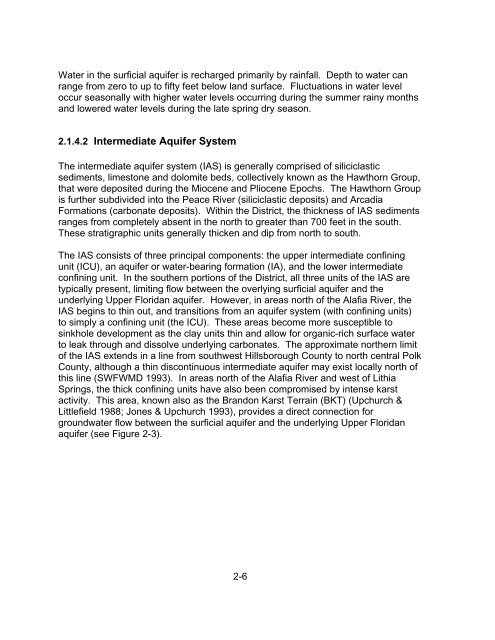Alafia River Minimum Flows and Levels - Southwest Florida Water ...
Alafia River Minimum Flows and Levels - Southwest Florida Water ...
Alafia River Minimum Flows and Levels - Southwest Florida Water ...
You also want an ePaper? Increase the reach of your titles
YUMPU automatically turns print PDFs into web optimized ePapers that Google loves.
<strong>Water</strong> in the surficial aquifer is recharged primarily by rainfall. Depth to water can<br />
range from zero to up to fifty feet below l<strong>and</strong> surface. Fluctuations in water level<br />
occur seasonally with higher water levels occurring during the summer rainy months<br />
<strong>and</strong> lowered water levels during the late spring dry season.<br />
2.1.4.2 Intermediate Aquifer System<br />
The intermediate aquifer system (IAS) is generally comprised of siliciclastic<br />
sediments, limestone <strong>and</strong> dolomite beds, collectively known as the Hawthorn Group,<br />
that were deposited during the Miocene <strong>and</strong> Pliocene Epochs. The Hawthorn Group<br />
is further subdivided into the Peace <strong>River</strong> (siliciclastic deposits) <strong>and</strong> Arcadia<br />
Formations (carbonate deposits). Within the District, the thickness of IAS sediments<br />
ranges from completely absent in the north to greater than 700 feet in the south.<br />
These stratigraphic units generally thicken <strong>and</strong> dip from north to south.<br />
The IAS consists of three principal components: the upper intermediate confining<br />
unit (ICU), an aquifer or water-bearing formation (IA), <strong>and</strong> the lower intermediate<br />
confining unit. In the southern portions of the District, all three units of the IAS are<br />
typically present, limiting flow between the overlying surficial aquifer <strong>and</strong> the<br />
underlying Upper <strong>Florida</strong>n aquifer. However, in areas north of the <strong>Alafia</strong> <strong>River</strong>, the<br />
IAS begins to thin out, <strong>and</strong> transitions from an aquifer system (with confining units)<br />
to simply a confining unit (the ICU). These areas become more susceptible to<br />
sinkhole development as the clay units thin <strong>and</strong> allow for organic-rich surface water<br />
to leak through <strong>and</strong> dissolve underlying carbonates. The approximate northern limit<br />
of the IAS extends in a line from southwest Hillsborough County to north central Polk<br />
County, although a thin discontinuous intermediate aquifer may exist locally north of<br />
this line (SWFWMD 1993). In areas north of the <strong>Alafia</strong> <strong>River</strong> <strong>and</strong> west of Lithia<br />
Springs, the thick confining units have also been compromised by intense karst<br />
activity. This area, known also as the Br<strong>and</strong>on Karst Terrain (BKT) (Upchurch &<br />
Littlefield 1988; Jones & Upchurch 1993), provides a direct connection for<br />
groundwater flow between the surficial aquifer <strong>and</strong> the underlying Upper <strong>Florida</strong>n<br />
aquifer (see Figure 2-3).<br />
2-6
















